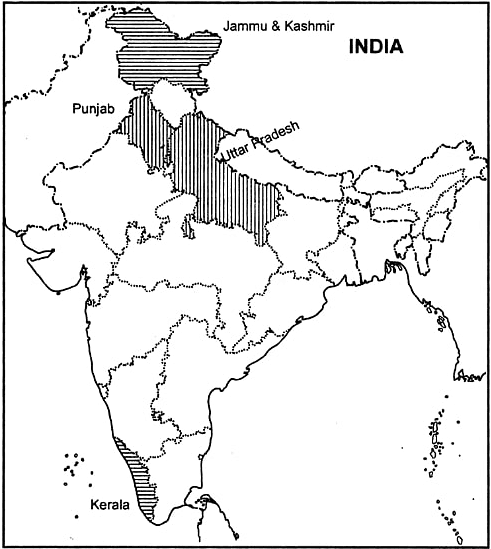NCERT Solutions for Class 12 Political Science - Era of One Party Dominance
Q1: Choose the correct option to fill in the blanks.
(a) The First General Elections in 1952 involved simultaneous elections to the Lok Sabha and _______ (The President of India/State Assemblies/Rajya Sabha/The Prime Minister)
(b) The party that won the second largest number of Lok Sabha seats in the first elections was the _______ (Praja Socialist Party/Bharatiya Jana Sangh/Communist Party of India/Bharatiya Janata Party)
(c) One of the guiding principles of the ideology of the Swatantra Party was _______ (Working class interest/protection of Princely States/Economy free from State control/Autonomy of States within the Union)
Ans:
(a) State Assemblies
In the first general elections held in 1952, elections were conducted simultaneously for the Lok Sabha (the lower house of India's Parliament) and the State Assemblies. This practice of holding concurrent elections was intended to streamline the electoral process and ensure a coordinated democratic exercise across the country.
(b) Communist Party of India
In the 1952 general elections, the Indian National Congress won the largest number of seats, securing a dominant position. The Communist Party of India emerged as the second largest party in terms of the number of seats won, reflecting its significant influence in certain regions, particularly in West Bengal and Kerala.
(c) Economy free from state control
The Swatantra Party, founded in 1959 by C. Rajagopalachari and other leaders, advocated for a liberal economic policy. It opposed the socialist policies and centralized planning promoted by the Indian National Congress. The party's guiding principles included advocating for an economy free from state control, promoting private enterprise, and reducing government intervention in economic matters.
Q2: Match the followingAns: (a)—(iv), (b)-(i), (c)-(ii), (d)-(iii)
Q3: Four statements regarding one-party dominance are given below. Mark each of them as true or false:
(a) One-party dominance is rooted in the absence of strong alternative political parties
(b) One-party dominance occurs because of weak public opinion.
(c) One-party dominance is linked to the nation’s colonial past.
(d) One-party dominance reflects the absence of democratic ideals in a country.
Ans:
(a) True
One-party dominance often occurs when there are no strong opposition parties to challenge the ruling party effectively. This can be due to various reasons, including a lack of resources, organizational structure, or public support for alternative parties.
(b) False
One-party dominance is not necessarily a result of weak public opinion. It can happen even in countries with a strong and engaged public opinion if the ruling party has significant control over political processes, resources, or institutions that allow it to maintain power.
(c) True
In many post-colonial nations, the political party that led the independence movement often becomes the dominant party in the initial years of independence. This dominance can be attributed to the party's role in the struggle for independence and the trust it builds with the population.
(d) False
One-party dominance does not necessarily mean the absence of democratic ideals. It can occur in democratic systems where a single party is repeatedly chosen by the electorate due to its policies, leadership, or effectiveness. However, it becomes problematic if the dominance is maintained through undemocratic means like suppression of opposition, electoral fraud, or manipulation of democratic institutions.
Q4: Take a political map of India (with State outlines) and mark
(a) Two states where Congress was not in power at some point during 1952-67.
(b) Two states where the Congress remained in power through this period.
Ans:
(a) Kerala and Jammu & Kashmir.
(b) Punjab and Uttar Pradesh.
Q5: Read the following passage and answer the questions below:
“Patel, the organisational man of the Congress, wanted to purge the Congress of other political groups and sought to make of it a cohesive and disciplined political party. He …. sought to take the Congress away from its all-embracing character and turn it into a close-knit party of disciplined cadres. Being a ‘realist’ he looked more for discipline than for comprehension. While Gandhi took too romantic a view of “carrying on the movement,” Patel’s idea of transforming the Congress into strictly political party with a single ideology and tight discipline showed an equal lack of understanding of the eclectic role that the Congress, as a government, was to be called upon to perform in the decades to follow.” — Rajni Kothari
(a) Why does the author think that Congress should not have been a cohesive and disciplined party?
(b) Give some examples of the eclectic role of the Congress party in the early years.
(c) Why does the author say that Gandhi’s view about Congress’ future was romantic?
Ans:
(a) The author believes that Congress should not have been a cohesive and disciplined party because it needed to maintain its all-embracing character and understand the eclectic role it had to play.
(b) Examples of the eclectic role of the Congress party include its role in the national movement, representing diverse interests, and leading the country towards independence.
(c) The author suggests that Gandhi's view was romantic because he took a sentimental approach, emphasizing "carrying on the movement" without recognizing the need for a more disciplined and political party structure, as envisioned by Patel.
|
154 videos|985 docs|260 tests
|
FAQs on NCERT Solutions for Class 12 Political Science - Era of One Party Dominance
| 1. What was the main party that dominated the political landscape during the Era of One Party Dominance in India? |  |
| 2. How did the Era of One Party Dominance impact the political system in India? |  |
| 3. What factors contributed to the dominance of a single party during this era? |  |
| 4. How did the Era of One Party Dominance come to an end in India? |  |
| 5. What were some of the consequences of the Era of One Party Dominance on the Indian political system? |  |

















